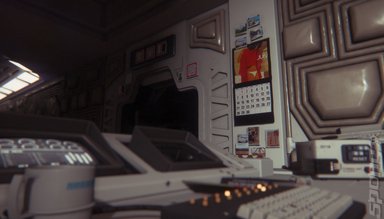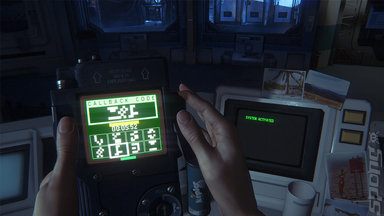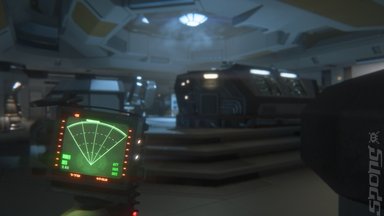Poing! The motion tracker announces in an increasingly upbeat tone that I have company. Or, rather, I might have company. I’d been desperate to get my hands on the tracker, and now I’m starting to regret it. Before, I was comparatively blissful in my unawareness of who – or what – was behind me or around the next corner. I might be greeted with some grizzly demise, but at least it would be quick. Instead – poing! – I’m being mocked by the device I thought would be my best pal.
A long, drawn out state of heightened awareness, anxiety, where I’m frozen as much by decision paralysis as with fear. Heart hammering. Should I go for it, or wait to see what else moves? Perhaps create a distraction to stir things up, to see who - or what - comes looking, and aim to get by unnoticed amidst the kerfuffle. This is Alien Isolation’s glory.
It hadn’t always been this way. At the outset, as the player first takes on the role Amanda Ripley (daughter of Alien’s Ellen Ripley, who at this point in the timeline is catching a snooze in deep space) everything’s nice and sedate. Wandering around the transport ship Torrens, woozy from hypersleep, you’re pitched back 35 years to a ship so reminiscent of the Nostromo’s living quarters, you half expect to find the ill-fated crew having breakfast in the mess (cough! splutter! burst!).
Before you know it, it’s time to depart for your destination - Sevastopol Station. A deep space trading outpost, you’re heading aboard to collect data recovered from the wreckage of the Nostromo, and hopefully discover the fate of Ripley Snr and the rest of the ship’s crew. From that point, “going to plan” is not in the playbook. The station isn’t responding to hails and the docking ports are in tatters. Taking a space walk over to the station was probably not the best course of action, and you’re soon separated from your team without the foggiest clue as to why the station is desolate.
Against a backdrop of ripped out wall panels, dilapidated light fixtures (cue deep, pendulous shadows), piles of crap everywhere and most definitely signs of a struggle or two, you might have to take a moment to shake of that feeling that you’ve stepped back 10 years to Doom III – lots of stark lighting versus unlit, unfathomable corners - every surface bevelled and shiny to grandstand the lighting effects.
Despite the junk and damage, there’s a clinical feel to it. That glossiness, albedo on everything – it just doesn’t feel grubby enough. Which is a shame, because the design work, its intricacies and attention to details is outstanding – it could just do with more dirtying down. So with the lights a-swinging and shadows so deep you’d think (it if wasn’t for the dust motes) that someone had left an airlock door open, you’re off in search of a few answers: Where is everybody? What happened to Mommy? Where are your team? How do you get off this wreck?
Clues are scant. You have objectives, but how you achieve them is pretty much down to you to figure out. This typically involves running up against unsavouries such as gangs and rogue androids, which with – initially – little more than more than harsh language to fend them off and no meaningful guidance, is your first call for frustration.
Forced to use cover and sneak around them, there are no cues as to your visibility. Crouched behind crates metres from a group of ne’er do wells, you’re thinking “there’s no way I can break between cover and not be spotted.” And yet, you can.
On the other hand, you may discover you’ve been spotted from a distance and angle from which you’d previously gone unseen. Only when foes are making a rapid line for you is it clear the game’s up – there’s no grand “what’s that?” gesture or any clear cue - so you’d better run, break line of sight and hide in a locker or under a desk and hold your breath and clutch your teddy bear (there’s no such thing as monsters, right?)
This isn’t an issue unique to Alien Isolation - many sneak ‘em ups have fallen foul. Though it’s not realistic, some cue or indication of enemy awareness would be much more enjoyable because, as it is, the matter of whether you’ll be seen feels as much guesswork as judgement.
So while you’re pondering “am I going to be seen this time”, you’ll also be wondering how you can improve your chances of not being seen. A while spent scavenging and the pocketful of scrap, glue, batteries and other assorted junk can be transformed (once you’ve found the blueprints) into flash bangs, smoke bombs and other means of throwing the enemy off your scent. These are as much your armoury as any real weaponry, which – fear not - you’ll also get your hands on.
Misdirection is essential for getting around without being noticed – or eaten. Air ducts and floor vents become the preferred route options. Hammer on a wall or lob a flash bang, then scamper into a duct to make a run-around and pick off one of the curious combatants. To further increase your chances, rewiring a power terminal opens up the possibility of activating or disabling alarms, doors, cameras, speaker systems, air vents and lighting.
The mix of crafting, hacking junction boxes and use of distraction brings a refreshing mix to what would otherwise be a plain vanilla survival-horror, but it’s not without rough edges. The info on rerouting power doesn’t really give you any clarity on how long or what effect they’ll have – again, the player is left to figure it out. Coupled with the vagueness of cover, it’s starting to feel a bit more like trial and error than a case of making decisions based on cues and feedback. Yes, it ups the level of tension, but to the detriment of the gameplay.
And then, the you get the motion tracker.
At that point, everything goes up a gear. It feels like a new game. Empowered. You're suddenly able to make a decisive move. But that brings with it a whole set of other challenges.
The tracker only visualises movement within a cone directly ahead of you (though audibly, all around) and doesn’t indicate the direction an enemy is facing. It’ll also detect movement outside of the current area – say, in an inaccessible conduit or neighbouring room. So when you’re hunkered down waiting to make your move and the tracker goes haywire as something moves directly toward you, you’d better have a fresh pair of undies on hand.
It’s welcoming, then, that there’s an ebb and flow to the tension, as the threat moves between the visible, almost predictable movement of the regular, humanoid variety of enemy to the “now you see it, now you don’t” of the titular alien. When the critter first shows its face, you know right away that this is a whole different kettle of fish. No amount wrench swinging or rounds unleashed is going to see it off - and it moves fast. Unless you’ve got a place to hide within strides, you’re lunch. Its movement is utterly unpredictable, as it leaps into ducts and re-emerges from any number of other vents, that without a tracker you really are just using pot luck.
Even with a tracker, the alien’s speed and erratic moves make these sections some of the most tense gaming ever encountered. It’s after these that you’re delighted to have to deal with more manageable enemies: looters, gangs and androids all seem like pleasure next to the xenomorph.
A long, drawn out state of heightened awareness, anxiety, where I’m frozen as much by decision paralysis as with fear. Heart hammering. Should I go for it, or wait to see what else moves? Perhaps create a distraction to stir things up, to see who - or what - comes looking, and aim to get by unnoticed amidst the kerfuffle. This is Alien Isolation’s glory.
It hadn’t always been this way. At the outset, as the player first takes on the role Amanda Ripley (daughter of Alien’s Ellen Ripley, who at this point in the timeline is catching a snooze in deep space) everything’s nice and sedate. Wandering around the transport ship Torrens, woozy from hypersleep, you’re pitched back 35 years to a ship so reminiscent of the Nostromo’s living quarters, you half expect to find the ill-fated crew having breakfast in the mess (cough! splutter! burst!).
Before you know it, it’s time to depart for your destination - Sevastopol Station. A deep space trading outpost, you’re heading aboard to collect data recovered from the wreckage of the Nostromo, and hopefully discover the fate of Ripley Snr and the rest of the ship’s crew. From that point, “going to plan” is not in the playbook. The station isn’t responding to hails and the docking ports are in tatters. Taking a space walk over to the station was probably not the best course of action, and you’re soon separated from your team without the foggiest clue as to why the station is desolate.
Against a backdrop of ripped out wall panels, dilapidated light fixtures (cue deep, pendulous shadows), piles of crap everywhere and most definitely signs of a struggle or two, you might have to take a moment to shake of that feeling that you’ve stepped back 10 years to Doom III – lots of stark lighting versus unlit, unfathomable corners - every surface bevelled and shiny to grandstand the lighting effects.
Despite the junk and damage, there’s a clinical feel to it. That glossiness, albedo on everything – it just doesn’t feel grubby enough. Which is a shame, because the design work, its intricacies and attention to details is outstanding – it could just do with more dirtying down. So with the lights a-swinging and shadows so deep you’d think (it if wasn’t for the dust motes) that someone had left an airlock door open, you’re off in search of a few answers: Where is everybody? What happened to Mommy? Where are your team? How do you get off this wreck?
Clues are scant. You have objectives, but how you achieve them is pretty much down to you to figure out. This typically involves running up against unsavouries such as gangs and rogue androids, which with – initially – little more than more than harsh language to fend them off and no meaningful guidance, is your first call for frustration.
Forced to use cover and sneak around them, there are no cues as to your visibility. Crouched behind crates metres from a group of ne’er do wells, you’re thinking “there’s no way I can break between cover and not be spotted.” And yet, you can.
On the other hand, you may discover you’ve been spotted from a distance and angle from which you’d previously gone unseen. Only when foes are making a rapid line for you is it clear the game’s up – there’s no grand “what’s that?” gesture or any clear cue - so you’d better run, break line of sight and hide in a locker or under a desk and hold your breath and clutch your teddy bear (there’s no such thing as monsters, right?)
This isn’t an issue unique to Alien Isolation - many sneak ‘em ups have fallen foul. Though it’s not realistic, some cue or indication of enemy awareness would be much more enjoyable because, as it is, the matter of whether you’ll be seen feels as much guesswork as judgement.
So while you’re pondering “am I going to be seen this time”, you’ll also be wondering how you can improve your chances of not being seen. A while spent scavenging and the pocketful of scrap, glue, batteries and other assorted junk can be transformed (once you’ve found the blueprints) into flash bangs, smoke bombs and other means of throwing the enemy off your scent. These are as much your armoury as any real weaponry, which – fear not - you’ll also get your hands on.
Misdirection is essential for getting around without being noticed – or eaten. Air ducts and floor vents become the preferred route options. Hammer on a wall or lob a flash bang, then scamper into a duct to make a run-around and pick off one of the curious combatants. To further increase your chances, rewiring a power terminal opens up the possibility of activating or disabling alarms, doors, cameras, speaker systems, air vents and lighting.
The mix of crafting, hacking junction boxes and use of distraction brings a refreshing mix to what would otherwise be a plain vanilla survival-horror, but it’s not without rough edges. The info on rerouting power doesn’t really give you any clarity on how long or what effect they’ll have – again, the player is left to figure it out. Coupled with the vagueness of cover, it’s starting to feel a bit more like trial and error than a case of making decisions based on cues and feedback. Yes, it ups the level of tension, but to the detriment of the gameplay.
And then, the you get the motion tracker.
At that point, everything goes up a gear. It feels like a new game. Empowered. You're suddenly able to make a decisive move. But that brings with it a whole set of other challenges.
The tracker only visualises movement within a cone directly ahead of you (though audibly, all around) and doesn’t indicate the direction an enemy is facing. It’ll also detect movement outside of the current area – say, in an inaccessible conduit or neighbouring room. So when you’re hunkered down waiting to make your move and the tracker goes haywire as something moves directly toward you, you’d better have a fresh pair of undies on hand.
It’s welcoming, then, that there’s an ebb and flow to the tension, as the threat moves between the visible, almost predictable movement of the regular, humanoid variety of enemy to the “now you see it, now you don’t” of the titular alien. When the critter first shows its face, you know right away that this is a whole different kettle of fish. No amount wrench swinging or rounds unleashed is going to see it off - and it moves fast. Unless you’ve got a place to hide within strides, you’re lunch. Its movement is utterly unpredictable, as it leaps into ducts and re-emerges from any number of other vents, that without a tracker you really are just using pot luck.
Even with a tracker, the alien’s speed and erratic moves make these sections some of the most tense gaming ever encountered. It’s after these that you’re delighted to have to deal with more manageable enemies: looters, gangs and androids all seem like pleasure next to the xenomorph.





